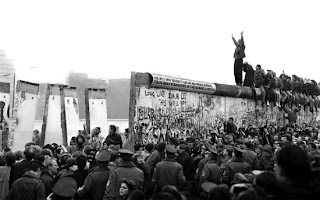A few weeks ago during our unit on WW2 we viewed segments of
Triumph of the Will. I've asked a good friend, former SBS Dean of Students, and historian
Nathan Barber to offer commentary about the film. He's read your comments from the
previous post, and responded with what I've posted below. Read his response, and leave your comments (i.e., additional questions, follow-up points, etc.). Avail yourselves of this great opportunity for additional dialogue about this most important film.
Thanks, Nathan!
********************************************
Dear Dr. Sinitiere and the SBS Euro classes,
Thank you for providing me the opportunity to participate in your
Triumph of the Will assignment. I trust that each of you understand and appreciate the significance of the film you watched. Riefenstahl’s film has been both praised and vilified in the years since its release more than seventy years ago. Hitler issued a blank check to Riefenstahl to complete the project and she gladly accepted the challenge. As historians, you must remember the historical context of the project: the mid-1930s when the Nazi party had begun its climb to power out of the rubble and ruin that was post-WWI Germany. Riefenstahl could not have known where Hitler would lead the Nazi party and Germany over the next decade. For most who have vilified Riefenstahl and her work, the issue is whether or not she knew, at the height of Nazi power, the extent to which Hitler and the Nazis had taken their anti-Semitic nationalism. Evidence may suggest she knew but failed to separate herself from the party.
Let’s take a look at the film itself. Based on your blog comments, you clearly picked up on much of the symbolism, themes and allusions in Riefenstahl’s film. Well done. I’m impressed with your astute observations and articulate comments. I would like to offer two of my own observations for your consideration, observations that were not noted in the classes’ comments.
First, the film looks in retrospect to be propaganda. I cannot argue this point. I ask you, however, to consider Riefenstahl and her approach to the project. What she created was a portrait of Hitler and the Nazi party. Think back to your study of the Renaissance, specifically of Renaissance art. During this time, patrons commissioned the greatest artists of the day to create portraits. The visual description or likenesses portrayed the patrons as the patrons wished to be perceived by the viewer, perhaps strong or valiant or rich. Hitler, the patron, commissioned Riefenstahl, an artist, to create a portrait fashioned with camera and film rather than with brush and canvas. The finished work,
Triumph of the Will, provides the viewer with the description or likeness of Hitler and the Nazis exactly as Hitler hoped: as savior and messiah for a broken and suffering people. Did you notice the joy and excitement on the faces of the Germans in the film in spite of the fact that their nation lay in economic shambles around them? Riefenstahl’s intent was to illustrate how Hitler and the Nazis gave the Germans hope. Your interpretation of Riefenstahl’s Hitler as a savior, as a messiah, as a divine figure, serves as evidence that Riefenstahl succeeded in creating the portrait Hitler desired. I offer to you that perhaps Riefenstahl the artist, not the propagandist, created
Triumph of the Will as art and the Nazis then used the art as propaganda. After all, in that sense, is a commissioned portrait any different inasmuch as it is designed to propagate a particular idea about the subject of the portrait? This is not to suggest, though, that Riefenstahl didn’t know how her art would be used.
Second, I’d like to bring to your attention a certain bit of irony about
Triumph of the Will. Though your comments did not indicate that you discovered this, I wonder if any of you noticed where the rally in the film was held. The rally in the film took place in Nuremberg as did so many similar rallies over the next dozen years. The irony? The famous trials in which Nazi war criminals were convicted also were held in Nuremberg. Coincidence? Not likely. While Berlin originally seemed an ideal location for the trials, Nuremberg offered a more suitable venue and seemed a fitting place to put to death the Nazi spirit which had, in a sense, been born out of the Nuremberg rallies in the 1930s.
Thank you again for the opportunity to offer a few thoughts on
Triumph of the Will for your consideration. I look forward to any comments you may have. And for those of you taking the AP exam, I wish each of you all the best in the rest of your AP Euro course and on the exam, which happens to be just over the horizon.





